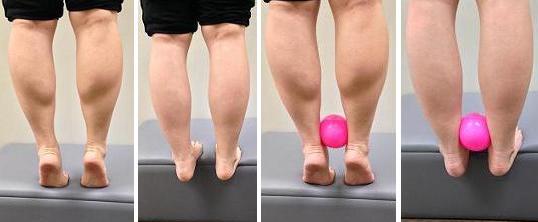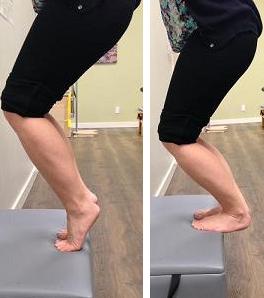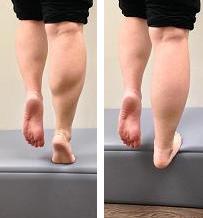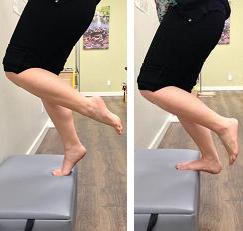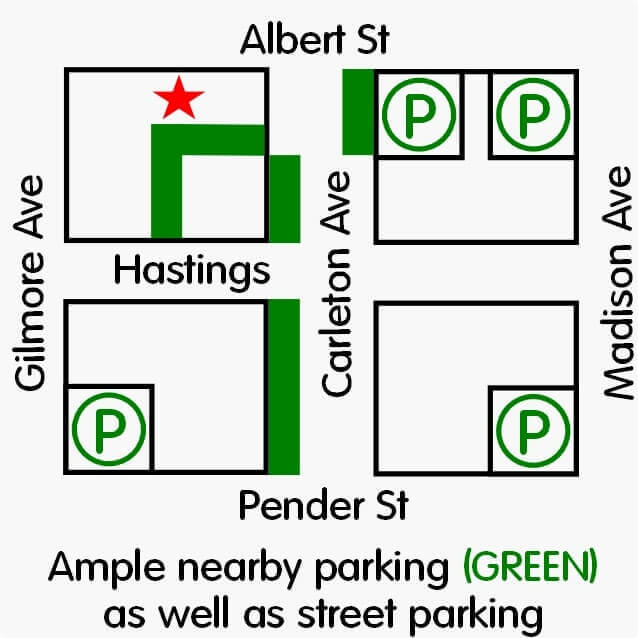
Eccentric Calf And Achilles Tendon Strengthening
For many dancers and athletes in general, having strong calves and achilles tendons are crucial to your ability to perform at your best. This will also help to reduce your risk of injury and tendonitis in your achilles. Here are some simple exercises you can do at home to strengthen your achilles and calves.
1. Straight knee, double heel lowering over a step
- Place both of your feet on the edge of a step in demi-pointé position (balls of the feet) and hold on to a wall or barre for balance
- Slowly lower your heels until they fall just below the level of the step
- Replace your feet in demi-pointé position, try not to do an active heel rise to the starting position
- Repeat 15 times for 3 sets
- Make sure that you stand up tall and keep your feet and arches “on” at all times
- Using a small ball between your ankles may help maintain your feet in a better position
2. Bent knee, double heel lowering over a step
- Same position as in #1 but this time bend both of your knees a little, about ~20o
- Make sure that both of your knees are pointing in the same direction as your 2nd toe
- Slowly lower yourself until both of your heels fall below the level of the step
- Repeat 15 times for 3 sets
3. Single leg heel drop, straight knee
- Place your feet on the edge of a step in demi-pointé position (balls of the feet) while gently holding on for balance
- Transfer your weight to one foot, slowly lower your heel to just past the level of the step
- Repeat 15 times for 3 sets on each leg
4. Single leg heel drop, bent knee
- Same position as in #3, but bend your knees slightly, about 20o
- Make sure that your knees are in line with your 2nd toe
- Slowly lower your heel past the level of the step
- Repeat 15 times for 3 sets on each leg
5. Parallel and turn out positioning
Do exercises (1) and (2) daily for 1 week. If there is no pain with the exercises, then progress to (3) and (4) for 2-3 weeks. If you are a dancer or gymnast, you can do the exercises in parallel and in turn out positions:
When doing these exercises, remember to:
- Maintain good posture during the exercises
- If you are a dancer or gymnast, do the exercises with no shoes. Otherwise, you may do the exercises while wearing runners
Learn The Best Exercises To Help Your Dance And Sports Performance
Your physiotherapist can help you develop the perfect exercise program to help you strengthen and protect your body from the physical rigors of dance and other activities. Learn how to improve your balance, stability and sport performance.
More importantly, learn how to avoid injury so you can stay in the game
Frequently Asked Questions
Q: Can I dance with achilles tendonitis?
A: Many dancers suffer from achilles tendonitis, especially those on pointe. Dancing while injured increases the possibility that you will either worsen your injury, delay healing or even need to be off your feet for longer.
If you are dealing with achilles tendonitis, having proper treatment, rest, conditioning and training will go a long way to helping you recover from your injury. With any injury, it is always best to seek the advice and care of your dance physiotherapist. They can help guide you on the safest way and timeline in returning to your dance and activity
Q: How do I strengthen my calves for dancing?
A: In addition to calf specific exercises, other ways to strengthen you calves include walking, running and hiking especially uphill.
While strength is certainly important, maintaining flexibility in your calves can also go a long way to preventing tendonitis and other injuries. Always try to stretch your calves and other muscles after dance to maintain their flexibility and resilience to strain or injury
Q: What happens if I do not treat my achilles tendonitis?
A: Without treatment, your achilles tendonitis injury could get worse over time. This could lead to chronic pain and tearing of the tendon, potentially requiring surgical repair.
Generally, the sooner you seek care for an injury the quicker you will recover. This will also shorten the length of down time you may need to take as you recover and wait to return to dance or your activity
Q: Can physiotherapy help achilles tendonitis?
A: Your dance physiotherapist can certainly help you deal with achilles tendonitis. When you see you physio, they will first assess you to find out why you developed tendonitis in your achilles tendon in the first place. Afterwards, they will review and discuss the best treatment options for you.
In treating your achilles tendonitis, your treatments may involve hands-on manual therapy, use of electrical modalities, taping or bracing and education. In all likelihood, your rehab program will also include various exercises to stretch and strengthen the various muscles around your ankle and leg. Your rehab may include the gradual re-introduction of dance specific movements and techniques as you prepare to gradually return to activity.
Q: How long is physical therapy for achilles tendonitis?
A: How long it takes for your achilles tendon to heal can depend on a few different factors. The mechanism of injury or reasons your achilles was injured in the first place can affect your timeline for recovery. The type of sport or activity you are involved in, as well as the level at which you participate will also determine your fast you heal.
During treatment, how involved you are in your care is often strongly correlated with your rate of progress. For some patients, they may notice improvements after just a few short visits. For others, recovery may take time extending into several months. If you have questions about your achilles tendon and recovery, speak with your physiotherapist. They can help you understand the recovery process as well as give you an idea of how long it will take
